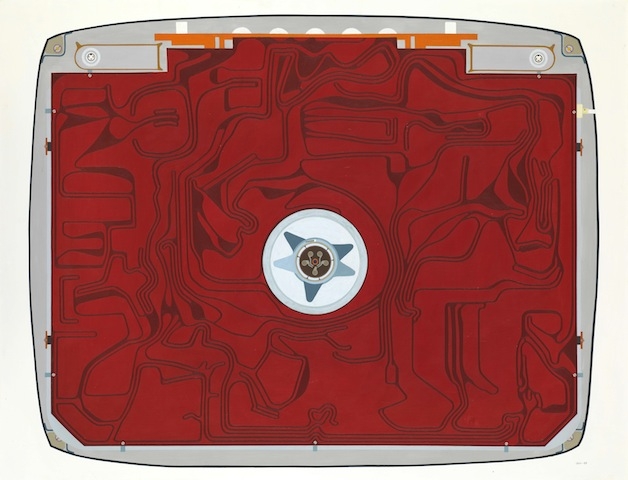That the invention of computer and networked technologies has impacted on our lives is a given. Looking at how artists have responded to this is a far more complex proposition, and one of which Electronic Superhighway, despite featuring work spanning five decades by 100 artists, can only offer a snapshot. Employing a reverse chronology, the show opens by immersing the viewer into a scattergun selection of works from the past 15 years that touch on, but go no deeper into, themes of interactivity and virtual community, authenticity, information overload and surveillance. Olaf Breuning’s giant cutout of a woman’s bare backside overlaid with phone-text speech bubbles, Text Butt (2015), jostles for attention with James Bridle’s holographic installation Homo Sacer (2014), which spouts diktats on citizenship, and Trevor Paglen and Jacob Appelbaum’s Autonomy Cube (2014), an open, Tor-routed wifi hotspot. As on the Internet itself, breezy pop-culture banality butts up (quite literally) against serious concerns about transparency and control.
Camille Henrot’s 13-minute video Grosse Fatigue (2013) attempts to explore the impossibility of encompassing the story of creation through the impossibility of focusing on the sheer volume of information about the subject. This work, having won the Silver Lion at Venice, may have been shown many times before, but that didn’t excuse the visitors sitting in the video’s booth on my visit, who, rather than focusing on the video, were busy scrolling through emails on their smartphones. Perhaps though it did strengthen Henrot’s point. There is more scrolling in Evan Roth’s long printout of all the images searched for by the artist in a day, Internet Cache Self Portrait: November 24, 2015 (2015). If Roth’s gesture seems a simplistic one, it’s because many of us don’t need to be shown the time and space that this type of activity takes up in our everyday lives; we’re more than aware of it.
As the exhibition travels back in time, the more outdated the technology featured in the works, the more aesthetically appealing the works can become. This can detract from their meaning, particularly when URL-based Net artworks from the 1990s, such as Heath Bunting’s _readme.html (1998), trigger a sense of nostalgia in the same way that playing early computer games like Pac-Man or Pong can do.
Focusing on the late 1960s to the early 1990s, the latter part of the exhibition (in terms of visitor journey) is in some ways the more interesting. This is not only because it gives equal importance in the show’s overall narrative to pioneers of video and screen-based art, such as Nam June Paik and Lynn Hershman Leeson, as to the post-1980s, digital-native generation, but also because there’s an energy and enquiring engagement in these works that seem missing in the selection of works from 2000 onwards.
Lesser-known artists given space in this section include Stockholm-based Ulla Wiggen, who painted cross-sections of the inside of electronic machines during the 1960s, and who participated in interdisciplinary art and technology group E.A.T.’s (Experiments in Art and Technology) 9 Evenings performances in New York in 1966. Documentation from those events, where a sense of excitement again seems more palpable, marks the exhibition’s chronological starting point.
Another artist deserving of the attention she gets here is Hungarian-born, Paris-based Vera Molnar. Now in her nineties, Molnar was one of a group of artists who used computer algorithms as a tool for creating beguiling geometric drawings during the 1960s. ‘The computer helps, but it does not “do”, does not “design” or “invent” anything,’ Molnar stated in 1990. ‘This machine, as impressive as it may be, is after all merely a tool in the hand of the painter.’ It’s this message that the exhibition leaves me thinking about most. Without even touching on advances in Artificial Intelligence, one only needs to rewatch Eva and Franco Mattes’s video installation My Generation (2010), showing its grainy clips of monitors, keyboards and consoles being smashed to bits in frustration by their enraged users, to feel that maybe none of us are any longer fully in control.
Whitechapel Gallery, London 29 January – 15 May 2016
This article first appeared in the April 2016 issue of ArtReview
